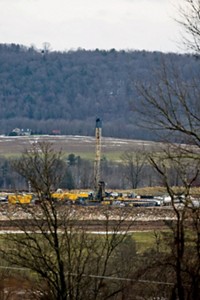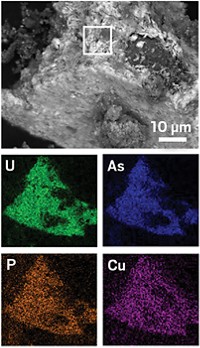Advertisement
Grab your lab coat. Let's get started
Welcome!
Welcome!
Create an account below to get 6 C&EN articles per month, receive newsletters and more - all free.
It seems this is your first time logging in online. Please enter the following information to continue.
As an ACS member you automatically get access to this site. All we need is few more details to create your reading experience.
Not you? Sign in with a different account.
Not you? Sign in with a different account.
ERROR 1
ERROR 1
ERROR 2
ERROR 2
ERROR 2
ERROR 2
ERROR 2
Password and Confirm password must match.
If you have an ACS member number, please enter it here so we can link this account to your membership. (optional)
ERROR 2
ACS values your privacy. By submitting your information, you are gaining access to C&EN and subscribing to our weekly newsletter. We use the information you provide to make your reading experience better, and we will never sell your data to third party members.
Water
Arsenic and other metals contaminate Navajo Nation and Alaska Native wells
Improving the water infrastructure in these areas to combat the contamination will require creative solutions, experts say
by Katherine Bourzac
August 28, 2019

For many people living in rural parts of the US, getting a glass of water to drink is not as simple as turning on the tap. It might start with a 50-mile drive on an unpaved road to buy water or pumping untreated water from a nearby well.
If you look at a US map highlighting regions that lack proper water infrastructure, two places stand out: much of rural Alaska, particularly where Alaska Native community members live, and the Navajo Nation, which is located in the Four Corners region in the Southwest. This Sunday at the American Chemical Society National Meeting in San Diego, researchers presented results from water quality tests of wells in both places. Some wells in each of these areas contained high levels of arsenic, sometimes at concentrations exceeding the limit set by the US Environmental Protection Agency. Arsenic is a carcinogen, and can cause or exacerbate other health problems. Other metals were also present in the water at unsafe levels.
Navajo Nation land is rich in natural resources including coal and copper, and was extensively mined for a century—particularly for uranium. There are 523 abandoned uranium mines and over 1,000 abandoned preliminary dig sites on the lands. Though the Navajo Nation banned uranium mining in 2005, the legacy of the extraction remains, said Jani Ingram, a chemist at Northern Arizona University and a member of the Navajo Nation. The element contaminates much of the region’s groundwater. What’s less appreciated both by community members and by water quality researchers, Ingram said, is that the region’s water is also contaminated with arsenic and other elements, much of which were also mobilized by mining operations. “Arsenic is a major, perhaps underappreciated, concern,” she said.
At a session in the Division of Environmental Chemistry, Ingram described her team’s work assessing elemental contamination in about 350 Navajo Nation wells. Ingram collaborated with researchers at the University of New Mexico, who performed some of the testing. Many of the wells are designated only for watering livestock, such as sheep, she said. However, about 30% of people living in Navajo Nation have no access to water in their homes, and must drive long distances to buy clean water at a steep price. Due to this inconvenience and expense, Ingram is concerned that people may be drinking from contaminated wells marked for livestock use. In her study, “wells in every region exceeded maximum contamination limits,” she said. In addition to uranium and arsenic, the team also found elevated levels of vanadium, calcium, manganese, and lithium in some wells.
In addition to publishing these results (Int. J. Environ. Res. Public Health 2019, DOI: 10.3390/ijerph16152727), Ingram’s group has presented the information to local communities, which has led to more detailed warning signs at contaminated wells. She hopes this will further discourage people thinking about drinking the water. Ingram said she is now beginning to assess the potential effects of secondary exposure to arsenic and uranium in mutton and other meat from animals that drink from the wells.
Ingram heads up the Partnership for Native American Cancer Prevention, and hopes this work will create a basis for further research on the health effects of arsenic and uranium exposure in the Navajo Nation community. She’s also researching whether uranium has health effects that extend beyond its radioactivity.
At another talk in the same session, Lewis Stetson Rowles, a PhD student at the University of Texas at Austin, explained that Native Alaskan community members face similar water problems. About 80% of Alaska Natives live in rural areas, and 22% live below the poverty line. His group, led by environmental engineer Navid Saleh, sampled 22 groundwater wells and one surface-water source in rural Alaska, located within seven tribal entities and one town with a large population of Native Alaskans. Rowles and Saleh’s interests were twofold. First, they wanted to measure metal levels and assess water quality. Second, the group wanted to provide baseline information about the microbial populations living in the water to assess how they might shift as a result of climate change.
Rowles said the team found lead in several households’ wells. Arsenic was also a problem, though some communities are treating for it—measures the University of Texas team found to be effective. Arsenic might have entered the water supply from gold mining and volcanos in the region, Rowles said. Contamination with aluminum, iron, and manganese was also common in the wells. There are possible health risks associated with these metals, especially for babies. And some people’s water has such high metal levels that, Rowles said, people claim they come out “shiny like a penny” after they shower.
The team didn’t find concerning levels of pathogenic bacteria. They did see an interesting mix of microbes, including both thermophiles and bacteria that can live only at below freezing temperatures. Rowles said the bacterial communities might shift as warmer temperatures and permafrost melt release dissolved organic material into the water, and as salt water infiltrates fresh water at lower elevations due to sea level rise.

Centralized water treatment infrastructure that’s designed for densely populated, relatively affluent areas won’t work in much of Alaska, Navajo Nation, or other rural areas in the US. “You have to be really creative in how to solve these issues,” says Rowles.
Jonathan Credo, an MD/PhD student at Arizona State University who’s collaborating with Ingram, points out that sometimes what seems like an obvious solution to these water problems actually just creates a new problem. For example, if Navajo Nation community members used uranium filters, they would then have to figure out how to dispose of solid waste full of concentrated uranium. And it is illegal to transport uranium in Navajo Nation, a regulation related to efforts to stop uranium extraction on community land.
North Carolina State University environmental engineer Joshua Kearns, who presided over the Sunday session, echoed Rowles’ call for creative solutions. “A common theme is, these people are poor economically, and living in rural areas where centralized infrastructure would be really expensive,” he said. In these areas, “connecting people to large sewers or drinking water infrastructure doesn’t make sense.” He hopes more chemists and engineers will turn their attention to these challenges, perhaps by working on water treatment technologies that work at the household or neighborhood scale.





Join the conversation
Contact the reporter
Submit a Letter to the Editor for publication
Engage with us on Twitter